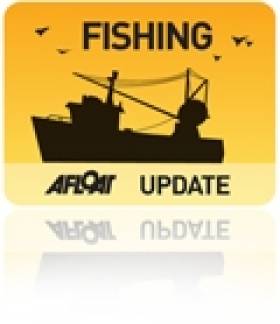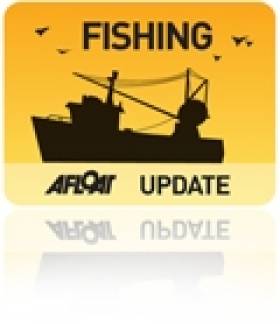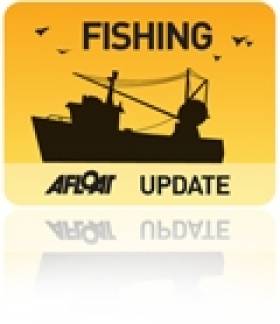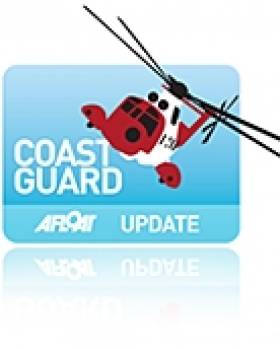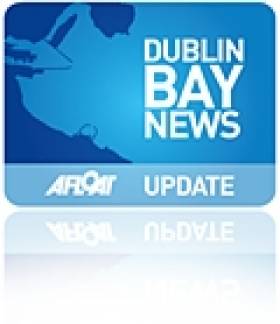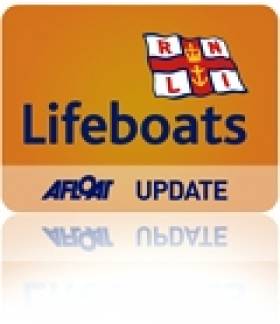Displaying items by tag: Fishing
Morning Ireland Reports On Galway Bay Fish Farm Debate
#FishFarm - RTÉ Radio 1's Morning Ireland reports on last night's public meeting in Galway on the proposed deep sea fish farm in Galway Bay.
As previously reported on Afloat.ie, the 500-hectare organic salmon farm proposed by Bord Iascaigh Mhara (BIM) would be located off Inis Oírr in the Aran Islands, and would be the largest of its kind in Europe, set to double the State's production rate of organic salmon.
BIM's aquaculture development manager Donal McGuire moved to reassure concerned locals that the agency was "not about to damage [its] reputation" by "doing something foolish or doing something that will cause serious environmental damage".
McGuire added that organic salmon is Ireland's leading organic food export but is in "very very short supply", and that business would be lost to producers in Scotland and Norway.
However, the scheme has faced strong opposition from fisheries groups and local anglers citing the potential environmental impact on wild salmon numbers and the threat to tourism in the area.
At last night's meeting, RTE's western correspondent Pat McGrath says just two of the more than 100 in attendance spoke in support of the fish farm plans.
Another public meeting on the proposals is scheduled for tonight in Rossaveal.
BIM is expected to hold a public tender process for the proposed salmon farm project pending approval by Marine Minister Simon Coveney.
Marine Notices on Vessel Maintenance and Accessibility
#MarineNotice - A recent Marine Notice from the Department of Transport, Tourism and Sport (DTTAS) raises importance of maintenance as highlighted in the MCIB report into the scuttling of fishing vessel Jeanette Roberta in Glandore Harbour in late 2011.
As previously reported on Afloat.ie, the prawn boat was returning to port on 11 December 2011 when the skipper had difficulty switching the helm from auto-pilot to manual due to a known issue with "sticky solenoids". The boat subsequently veered off course without warning and was holed on rocks on Adam's Island.
The official report into the incident castigated the owner/skipper for continuing to sail the vessel with persistent navigation issues - and Marine Notice No 04 of 2013 reminds all fishing vessel operators to ensure that deficiencies with their vessels are rectified without delay.
It is the responsibility of the owner to ensure that a vessel is maintained and operated at all times in accordance with the requirements of the agreed Code of Practice. Owners of all vessels also have a legal obligation to operate their vessels in accordance with the law.
Meanwhile, the latest Marine Notice is directed at passenger vessel owners and operators - encouraging them to continue voluntary efforts to improve accessibility on their vessels.
A new questionnaire has been made available to inform the DTTAS about the extent of accessibility improvements introduced to maritime passenger transport services in the State.
Full details are included in Marine Notice No 05 of 2013, a PDF of which is available to read or download HERE.
Eamon Cusack Is New Chair of Institute of Fisheries Management
#Fishing - One of Ireland’s most eminent fisheries experts and a recent CEO of the Shannon Regional Fisheries Board has been elected chairman of the Institute of Fisheries Management.
Eamon Cusack will assume the chair at the UK-based international body that promotes sustainable management of freshwater and marine fisheries.
Cusack said he was “passionate” about protecting and rebuilding fisheries threatened by habitat damage and over-exploitation.
To ensure their future, he would seek to continue to build successful partnerships between government and non-government organisations.
Cusack succeeds Ian Dolben, who served as chairman over the past five years. Dolben credited the success of the institute during his term to members taking on voluntary roles, changing its public face and taking its members’ services to a new level.
Eamon Cusack has over 35 years’ experience in the development and management of inland fisheries, including EU-funded projects, and has been an active member of the institute for more than 30 years.
He is currently chairman of the Shannon Fishery Partnership, which advises on the management of the ESB’s fisheries on the River Shannon, and a director of Recreational Angling Ireland.
He was a ministerial appointee to the Irish Central Fisheries Board, which oversees Irish national fisheries policy and strategy.
A native of Galway, Cusack grew up on the banks of the River Dodder in Dublin. While a young member of Dodder Anglers, the largest angling club in Ireland, he became aware of the many pressures facing fisheries which began his lifelong interest in their management.
#fishing – The Minister for Agriculture, Food and the Marine, Simon Coveney today chaired the first meeting of Ireland's Presidency of the Agri/Fish Council. The Irish Presidency's overarching goal for the new CFP is for a sustainable, profitable and self reliant industry that protects and enhances the social and economic fabric of rural coastal communities dependent on the seafood sector, while balancing these objectives with the need to deliver sustainable fisheries for future generations.
At today's Agri/Fish Council Minister Coveney presented the priorities for fisheries during the Irish Presidency and the work programme for the 6 months ahead. Minister Coveney identified reform of the Common Fisheries Policy as the number one priority for the Irish Presidency.
The Minister presented a work programme to progress and adopt a new reformed Common Fisheries Policy. The ambitious work programme outlined the intention of reaching a Council agreement on the Basic Regulation of the Common Fisheries Policy at the February Council. In February, trialogues are to begin between the Council, Parliament and Commission on the Regulation of Common Markets Organisation. A Council agreement on the European Maritime and Fisheries Fund Regulation is planned for the April Council. This will allow for the opening of trialogue negotiations on all three regulations with a view to obtaining full political agreement during the Irish Presidency.
The Minister acknowledged the challenges ahead and emphasised the importance of the EU Parliament Council and Commission finding common ground on the issues such as delivering on maximum sustainable yield, the elimination of discards and regionalisation.
"Ireland's Presidency objective is to reach a political agreement on all three CFP Regulations by the end of June 2013. Clearly this objective can only be realised if there is strong commitment from the Council, the Parliament and the Commission. It is very important to note that there is significant common ground on many of the critical issues on the reform such as achieving MSY and the elimination of discards. There are divergent views on the detail of these policies but the core values are, I believe, accepted by all of the institutions", Minister Coveney commented.
An exchange of views on the key priorities and timing on the CFP Reform Package followed where Minister Coveney sought support for his objective of achieving political agreement. Ministers at the Council strongly supported the programme of work and timetable and committed to working constructively with the Presidency.
Other important areas discussed at Council included technical and control measures in the Skagerrak and the successful outcome of recent negotiations between the EU and Norway.
A lunchtime discussion was also held on the issue of institutional competencies with regard to multi-annual management plans. Minister Coveney stressed the importance of Council and Parliament working together to find an acceptable solution to the difficult issue of inter-institutional roles under Article 43 of the Lisbon Treaty
He concluded "As President of the EU Fisheries Council my overall vision is to build a modern and competitive fisheries sector which is important not only for jobs and growth, but also for sustainable, long-term global food security."
Coastguard Helicopter In Double Rescue On Sunday
#Coastguard - The Irish Coast Guard's Waterford-based rescue helicopter recovered two casualties in separate incidents on Sunday, according to the Irish Examiner.
One fisherman was retrieved from the French fishing vessel Larche some 50 nautical miles south of Cork after complaining of chest pains and difficulty breathing.
The man was winched on board coastguard helicopter Rescue 117 and transferred to hospital in Cork for treatment.
In a separate incident, a hillwalker was airlifted from Slievenamon in Tipperary after suffering leg injuries in a fall - the second such accident in the area over the weekend.
Important Fisheries Talks Continue in Brussels
#Fishing - Important talks on EU fisheries reform are continuing in Brussels after progress in Clonakilty recently, according to RTÉ News.
As previously reported on Afloat.ie, Marine Minister Simon Coveney welcomed a deal signed on Friday 18 January between the EU and Norway on allowable catches and quotas.
The agreement was seen as a positive move at the end of a week of talks at the National Seafood Centre, which followed a number of false starts due to difficulties in balancing mutual access and management arrangements.
Minister Coveney said that meetings taking place in Brussels today (28 January) are "about setting the scene for six months of intensive work" to produce dossiers for both the Common Fisheries Policy and the Common Agricultural Policy, for which he hopes definitive reforms can be achieved by this summer.
Both the CFP and CAP account for 40% of the European Union budget.
TD Slams 'Crazy' Howth Parking Charge Proposals
#Howth - "Disastrous" could be the effect for Howth's economy if car parking charges proposed by Government are introduced, as The Irish Times reports.
Tommy Broughan, Labour TD for Dublin North East, hit out at plans to charge for parking in the harbour area of the North Dublin fishing village, describing them as "crazy" and potentially devastating for Howth's marine and tourism industries.
He also criticised the failure of Marine Minister Simon Coveney and his department to consult with local stakeholders before pressing forward with the plans.
However, Minister of State Dinny McGinley argued that the vast majority of the 500 spaces available in Howth village were being used by park-and-ride commuters, and that only a small number of users involved in the fishing industry were effectively funding the service for all.
The Irish Times has more on the story HERE.
Clonakilty Welcomes Agreement on EU Fisheries
Minister Simon Coveney T.D. has welcomed the international fisheries agreement signed between the EU and Norway at 6am this morning.
The negotiations commenced in Clonakilty on Tuesday morning and were hosted by Ireland, who in its role of Presidency of the EU, co-ordinated the EU position in these international negotiations. The Minister said "the fact that this agreement was concluded in Clonakilty this morning is positive for our fishermen and allows fishermen and fish factories to get on with their business in the normal way in these important fisheries."
The negotiations agreed:
the total allowable catch (TAC) for important stocks that are managed by both EU and Norway.
the sharing of these stocks between EU and Norway
· the transfer of quotas between EU and Norway as part of a balanced deal in the interests of EU and Norwegian fishermen.
The negotiations covered many stocks in both the North Sea, the western waters around Ireland and Scotland and stocks in Norwegian waters.
Issues of particular interest to Ireland included the setting a total allowable catch for the €1 billion Mackerel fishery and the sharing of that between EU, Norway and the other participants in the Mackerel fishery. The agreement reached this morning allocated 90.38%
of the TAC for Mackerel to the European Union and Norway, which is a continuation of the normal sharing arrangement which EU and Norway have applied in recent years.
This arrangement does not reward Iceland or the Faroe Islands with any larger share of the Mackerel stock, which they both have been demanding in association with their overfishing of this stock in recent years. Minister Coveney said "I do not accept that Iceland or Faroes should have been rewarded for their overfishing by EU and Norway granting them larger quotas at these negotiations. EU and Norway have acted responsibly by cutting their own catches by 15% in response to scientific advice on the impact of Icelandic and Faroes overfishing on the Mackerel stock. Iceland and Faroes need to come back to the table with much more realistic expectations of the share of the stock they can expect, if we are to get the mackerel fishery back into a sustainable position in the interest of all parties"
Minister Coveney also said "I welcome the agreed 64% increase in the Blue Whiting Total Allowable Catch to 643,000 tonnes for 2013. This fishery is important for our fishermen and for our fish factories who process both Irish, Norwegian and Scottish catches of this species for human consumption exports." The Minister added that he also "welcomed the fact that the percentage of Blue Whiting TAC which is transferred by EU to Norway as a traditional part of this deal has been negotiated down from 7.7% last year to 7% this year which will increase the amount of Blue Whiting available to our fishermen." The agreement signed in Clonakilty paves the way for the final negotiations on access for EU vessels to Norwegian waters and Norwegian vessels to EU waters to be concluded in a final meeting in London next Tuesday.
Lifeboat Crews Tow Vessel From Rocks Off Waterford
#Lifeboats - TheJournal.ie reports that RNLI lifeboat crews from Dunmore East and Fethard rescued two fishermen from their vessel off the Waterford coast yesterday (14 January 2013).
Rescuers sped to the scene after the 10-metre fishing boat got into difficulty and grounded close to the shore north of Loftus Hall.
Despite the receding tide, the lifeboats managed to tow the vessel carefully off the rocks "without any major damage", according to a spokesperson. The two crew were uninjured in the incident.
It marked the third major call-out in a week off the Waterford coast - following a similar rescue effort last Tuesday, and just days after the tragic loss of a local fisherman on Thursday morning on the sixth anniversary of the sinking of Dunmore East trawler the Pere Charles.
Meanwhile, on Sunday afternoon volunteers with Achill Island RNLI went to the assistance of an injured fisherman off the Mayo coast.
The lifeboat station received the distress call around noon to go to the assistance of a fishing party north of Clare Island, where the crew removed a man from the vessel who had suffered an eye injury from a fishing hook.
He was subsequently transported on the lifeboat to Kildavnet, where a local doctor examined his injury before referring him to Castlebar General Hospital for further attention.
Fishing Negotiations Hosted by Ireland
#fishing – Ireland, on behalf of the European Union, is hosting important fisheries negotiations between Norway, Sweden, Denmark, Germany, Netherlands, Belgium, France, United Kingdom, Spain, Portugal and Ireland. These negotiations on the annual fishing arrangements for 2013 between the European Union (EU) and Norway commence at the National Seafood Centre in Clonakilty tomorrow, Tuesday the 15th January.
Economically one of the most important fishing agreements entered into by the EU, the talks involving Norway for 2013 have not concluded successfully so far due to difficulties on a number of fronts notably, balancing an exchange of fishing opportunities, mutual access arrangements, and cod management arrangements.
Over seventy delegates from across Europe and Norway will meet at the National Seafood Centre in Clonakilty for the week long talks.
The talks will in part deal with the arrangements for 2013 for the annual €1 billion mackerel fishery. It is expected that, in light of the continuing refusal of Iceland and the Faroe Islands to enter fair and appropriate management arrangements for mackerel, both the EU and Norway, as the largest shareholders of the North East Atlantic mackerel stock, will take this opportunity to finalise fishing limits for mackerel for 2013.
Minister for Agriculture, Food and the Marine Simon Coveney stated "I hope that the question of quotas for mackerel in particular are finalised this week to allow our industry plan for the year ahead. I also expect that with a successful outcome on the exchange of fishing quotas and access arrangements will enable the finalisation of quotas for other stocks such as Blue Whiting and the Herring in Norwegian waters which are of major importance to our pelagic fishing fleet. Agreement on access for Norwegian vessels to EU waters is also vital to facilitate the landing and processing of Norwegian Blue Whiting in our pelagic factories along the west and north west coasts. "
On mackerel the Minister added "I am very concerned about the ongoing crisis associated with the mackerel stock. It is imperative that pressure is applied to Iceland and the Faroes to cease their unsustainable fishing operations and come to the table with meaningful proposals to resolve the impasse. With that in mind, I am seeking a joint approach by Norway and the EU on appropriate measures to address the current overfishing of Mackerel by Iceland and the Faroes"
Concluding the Minister said "it is a good opportunity for Ireland, at the start of its Presidency of the European Union, to host these important talks and to put Ireland again centre stage in terms of our positive role within the European Union. Over seventy international delegates descending on Clonakilty for a week in mid January will bring a welcome boost to the local economy ".



























